A New Parallelized Computation Method of HASC-N Difference Scheme for Inhomogeneous Time Fractional Fisher Equation
Abstract
:1. Introduction
2. HASC-N Difference Scheme for Inhomogeneous TFFE
2.1. Inhomogeneous Time Fractional Fisher Equation
2.2. Construction of HASC-N Difference Scheme for Inhomogeneous TFFE
3. Existence and Uniqueness of Solution to HASC-N Difference Scheme for Inhomogeneous TFFE
4. Stability of HASC-N Difference Scheme for Inhomogeneous TFFE
5. Convergence of HASC-N Difference Scheme for Inhomogeneous TFFE
6. Numerical Tests
7. Conclusions
Author Contributions
Funding
Institutional Review Board Statement
Informed Consent Statement
Data Availability Statement
Acknowledgments
Conflicts of Interest
References
- Uchaikin, V.V. Fractional Derivatives for Physicists and Engineers, Volume II: Applications; Springer: Berlin, Germany, 2013. [Google Scholar]
- Rashid, S.; Hammouch, Z.; Aydi, H.; Ahmad, A.G.; Alsharif, A.M. Novel computations of the time-fractional Fisher’s model via generalized fractional integral operators by means of the Elzaki transform. Fractal Fract. 2021, 5, 94. [Google Scholar] [CrossRef]
- Li, C.P.; Zeng, F.H. Numerical Methods for Fractional Calculus; CRC Press: New York, NY, USA, 2015. [Google Scholar]
- Sabatier, J.; Agrawal, O.P. Advances in Fractional Calculus: Theoretical Developments and Applications in Physics and Engineering; Machado, J.A.T., Ed.; Beijing World Publishing Corporation: Beijing, China, 2014. [Google Scholar]
- Diethelm, K. The Analysis of Fraction Differential Equations; Springer: Berlin, Germany, 2010. [Google Scholar]
- Liu, F.W.; Zhuang, P.H.; Liu, Q.X. Numerical Methods and its Application of Fractional Partial Differential Equation; Science Press: Beijing, China, 2015. (In Chinese) [Google Scholar]
- Sun, Z.Z.; Gao, G.H. Finite Difference Methods for Fractional Differential Equations, 2nd ed.; Science Press: Beijing, China, 2021. (In Chinese) [Google Scholar]
- Guo, B.L.; Pu, X.K.; Huang, F.H. Fractional Partial Differential Equations and Their Numerical Solutions; Science Press: Beijing, China, 2015. [Google Scholar]
- Zhang, X.D.; He, Y.N.; Wei, L.L.; Tang, B.; Wang, S.L. A fully discrete local discontinuous Galerkin method for one-dimensional time-fractional Fisher’s equation. Int. J. Comput. Math. 2014, 91, 2021–2038. [Google Scholar] [CrossRef]
- Alquran, M.; Al-Khaled, K.; Sardar, T.; Chattopadhyay, J. Revisited Fisher’s equation in a new outlook: A fractional derivative approach. Phys. A 2015, 438, 81–93. [Google Scholar] [CrossRef]
- Mejía, C.E.; Piedrahita, A. A numerical method for a time-fractional advection–dispersion equation with a nonlinear source term. J. Appl. Math. Comput. 2019, 61, 593–609. [Google Scholar] [CrossRef]
- Al Qurashi, M.M.; Korpinar, Z.; Baleanu, D.; Mustafa Inc. A new iterative algorithm on the time-fractional Fisher equation: Residual power series method. Adv. Mech. Eng. 2017, 9, 1–8. [Google Scholar] [CrossRef] [Green Version]
- Khader, M.M.; Saad, K.M. A numerical approach for solving the fractional Fisher equation using Chebyshev spectral collocation method. Chaos Solitons Fractals 2018, 110, 169–177. [Google Scholar] [CrossRef]
- Li, D.F.; Liao, H.L.; Sun, W.W.; Wang, J.L.; Zhang, J.W. Analysis of L1-Galerkin FEMs for time-fractional nonlinear parabolic problems. Commun. Comput. Phys. 2018, 24, 86–103. [Google Scholar] [CrossRef] [Green Version]
- Veeresha, P.; Prakasha, D.G.; Baskonus, H.M. Novel simulations to the time-fractional Fisher’s equation. Math. Sci. 2019, 13, 33–42. [Google Scholar] [CrossRef]
- Petter, B.; Mitchell, L. Parallel Solution of Partial Differential Equations; Springer: New York, NY, USA, 2000. [Google Scholar]
- Pacheco, P. An Introduction to Parallel Programming; Morgan Kaufmann: Burlington, VT, USA, 2011. [Google Scholar]
- Gong, C.Y.; Bao, W.M.; Tang, G.J. A parallel algorithm for the Riesz fractional reaction-diffusion equation with explicit finite difference method. Fract. Calc. Appl. Anal. 2013, 16, 654–669. [Google Scholar] [CrossRef]
- Sweilam, N.H.; Moharram, H.; Moniem, N.K.A.; Ahmed, S. A parallel Crank–Nicolson finite difference method for time-fractional parabolic equation. J. Numer. Math. 2014, 22, 363–382. [Google Scholar] [CrossRef]
- Biala, T.A.; Khaliq, A.Q.M. Parallel algorithms for nonlinear time-space fractional parabolic PDEs. J. Comput. Phys. 2018, 375, 135–154. [Google Scholar] [CrossRef]
- Fu, H.F.; Wang, H. A preconditioned fast parareal finite difference method for space-time fractional partial differential equation. J. Sci. Comput. 2019, 78, 1724–1743. [Google Scholar] [CrossRef]
- Yue, X.Q.; Shu, S.; Xu, X.W.; Bu, W.P.; Pan, K.J. Parallel-in-time multigrid for space-time finite element approximations of two-dimensional space-fractional diffusion equations. Comput. Math. Appl. 2019, 78, 3471–3484. [Google Scholar] [CrossRef]
- Liu, H.; Cheng, A.J.; Wang, H. A parareal finite volume method for variable-order time-fractional diffusion equations. J. Sci. Comput. 2020, 85, 19. [Google Scholar] [CrossRef]
- Lorin, E. A parallel algorithm for space-time-fractional partial differential equations. Adv. Differ. Equ. 2020, 2020, 283. [Google Scholar] [CrossRef]
- Wang, Q.L.; Liu, J.; Gong, C.Y.; Tang, X.T.; Fu, G.T.; Xing, Z.C. An efficient parallel algorithm for Caputo fractional reaction-diffusion equation with implicit finite-difference method. Adv. Differ. Equ. 2016, 2016, 207. [Google Scholar] [CrossRef] [Green Version]
- Yang, X.; Wu, L. A New Kind of Parallel Natural Difference Method for Multi-Term Time Fractional Diffusion Model. Mathematics 2020, 8, 596. [Google Scholar] [CrossRef] [Green Version]
- Henry, B.I.; Langlands, T.A.M.; Wearne, S.L. Anomalous diffusion with linear reaction dynamics: From continuous time random walks to fractional reaction-diffusion equations. Phys. Rev. E 2006, 74, 031116. [Google Scholar] [CrossRef] [Green Version]
- Angstmann, C.N.; Henry, B.I. Time Fractional Fisher–KPP and Fitzhugh–Nagumo Equations. Entropy 2020, 22, 1035. [Google Scholar] [CrossRef]
- Sandev, T.; Tomovski, Z. Fractional Equations and Models: Theory and Applications; Springer: Berlin, Germany, 2019. [Google Scholar]
- Ngoc, T.B.; Tri, V.V.; Hammouch, Z.; Can, N.H. Stability of a class of problems for time-space fractional pseudo-parabolic equation with datum measured at terminal time. Appl. Numer. Math. 2021, 167, 308–329. [Google Scholar] [CrossRef]
- Dang, D.T.; Nane, E.; Nguyen, D.M.; Tuan, N.H. Continuity of Solutions of a Class of Fractional Equations. Potential Anal 2018, 49, 423–478. [Google Scholar] [CrossRef] [Green Version]
- Zhang, Y.N.; Sun, Z.Z. Alternating direction implicit schemes for the two-dimensional fractional sub-diffusion equation. J. Comput. Phys. 2011, 230, 8713–8728. [Google Scholar] [CrossRef]
- Liu, N.; Liu, Y.; Li, H.; Wang, J. Time second-order finite difference/finite element algorithm for nonlinear time-fractional diffusion problem with fourth-order derivative term. Comput. Math. Appl. 2018, 75, 3521–3536. [Google Scholar] [CrossRef]
- Wang, Y.; Liu, Y.; Li, H.; Wang, J. Finite element method combined with second-order time discrete scheme for nonlinear fractional cable equation. Eur. Phys. J. Plus 2016, 131, 61. [Google Scholar] [CrossRef]
- Zhang, B.L.; Gu, T.X.; Mo, Z.Y. Principles and Methods of Numerical Parallel Computation; National Defence Industry Press: Beijing, China, 1999. (In Chinese) [Google Scholar]
- Zhou, Y.L. Difference schemes with intrinsic parallelism for quasi-linear parabolic systems. Sci. China Math. 1997, 40, 270–278. [Google Scholar] [CrossRef]
- Stynes, M.; O’Riordan, E.; Gracia, J.L. Error analysis of a finite difference method on graded meshes for a time-fractional diffusion equation. SIAM J. Numer. Anal. 2017, 55, 1057–1079. [Google Scholar] [CrossRef]
- Shen, J.Y.; Sun, Z.Z.; Du, R. Fast finite difference schemes for time-fractional diffusion equations with a weak singularity at initial time. East Asian J. Appl. Math. 2018, 8, 834–858. [Google Scholar] [CrossRef]
- Yang, X.Z.; Liu, X.L. Numerical analysis of two new finite difference methods for time-fractional telegraph equation. Discrete Contin. Dyn. Syst. Ser. B 2021, 26, 3921–3942. [Google Scholar] [CrossRef]
- Evans, G.; Blackledge, J.; Yardley, P. Numerical Methods for Partial Differential Equations; Springer: Berlin, Germany, 2012. [Google Scholar]
- Kumar, D.; Chaudhary, S.; Srinivas Kumar, V.V.K. Fractional Crank–Nicolson–Galerkin finite element scheme for the time-fractional nonlinear diffusion equation. Numer. Methods Partial Differ. Equ. 2019, 35, 2056–2075. [Google Scholar] [CrossRef]
- Vong, S.; Lyu, P.; Wang, Z.B. A compact difference scheme for fractional sub-diffusion equations with the spatially variable coefficient under neumann boundary conditions. J. Sci. Comput. 2016, 66, 725–739. [Google Scholar] [CrossRef]
- Tverdyi, D.; Parovik, R. Investigation of Finite-Difference Schemes for the Numerical Solution of a Fractional Nonlinear Equation. Fractal Fract. 2022, 6, 23. [Google Scholar] [CrossRef]
- Long, L.D.; Luc, N.H.; Tatar, S.; Baleanu, D.; Can, N.H. An inverse source problem for pseudo-parabolic equation with Caputo derivative. J. Appl. Math. Comput. 2022, 68, 739–765. [Google Scholar] [CrossRef]
- Yuan, G.W.; Sheng, Z.Q.; Hang, X. The unconditional stability of parallel difference schemes with second order convergence for nonlinear parabolic system. J. Partial Differ. Equ. 2007, 20, 45–64. [Google Scholar]
- Deng, W.H.; Zhang, Z.J. High Accuracy Algorithms for the Differential Equation Governing Anomalous Diffusion, Algorithm and Models for Anomalous Diffusion; World Scientific: Singapore, 2019. [Google Scholar]

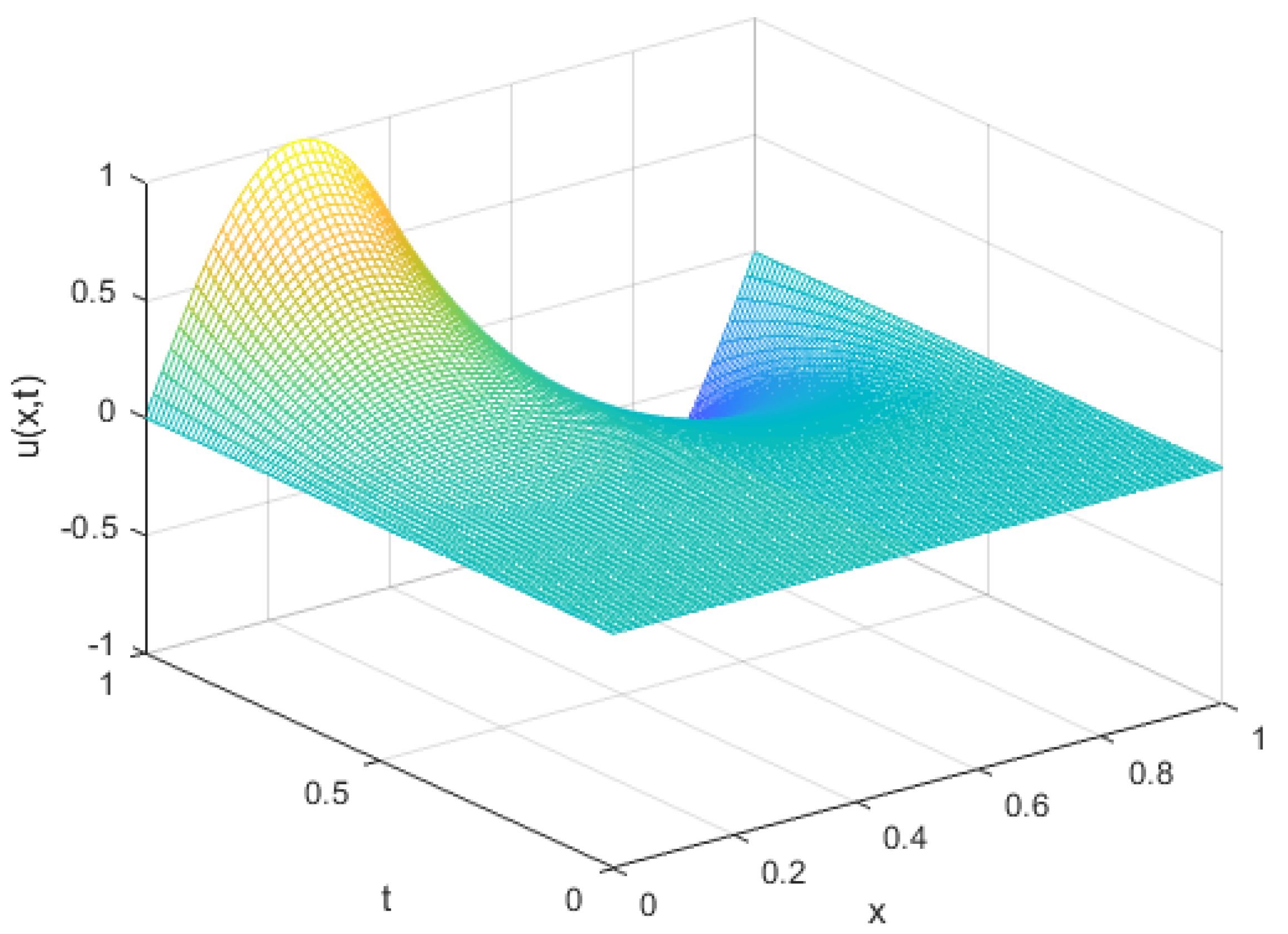
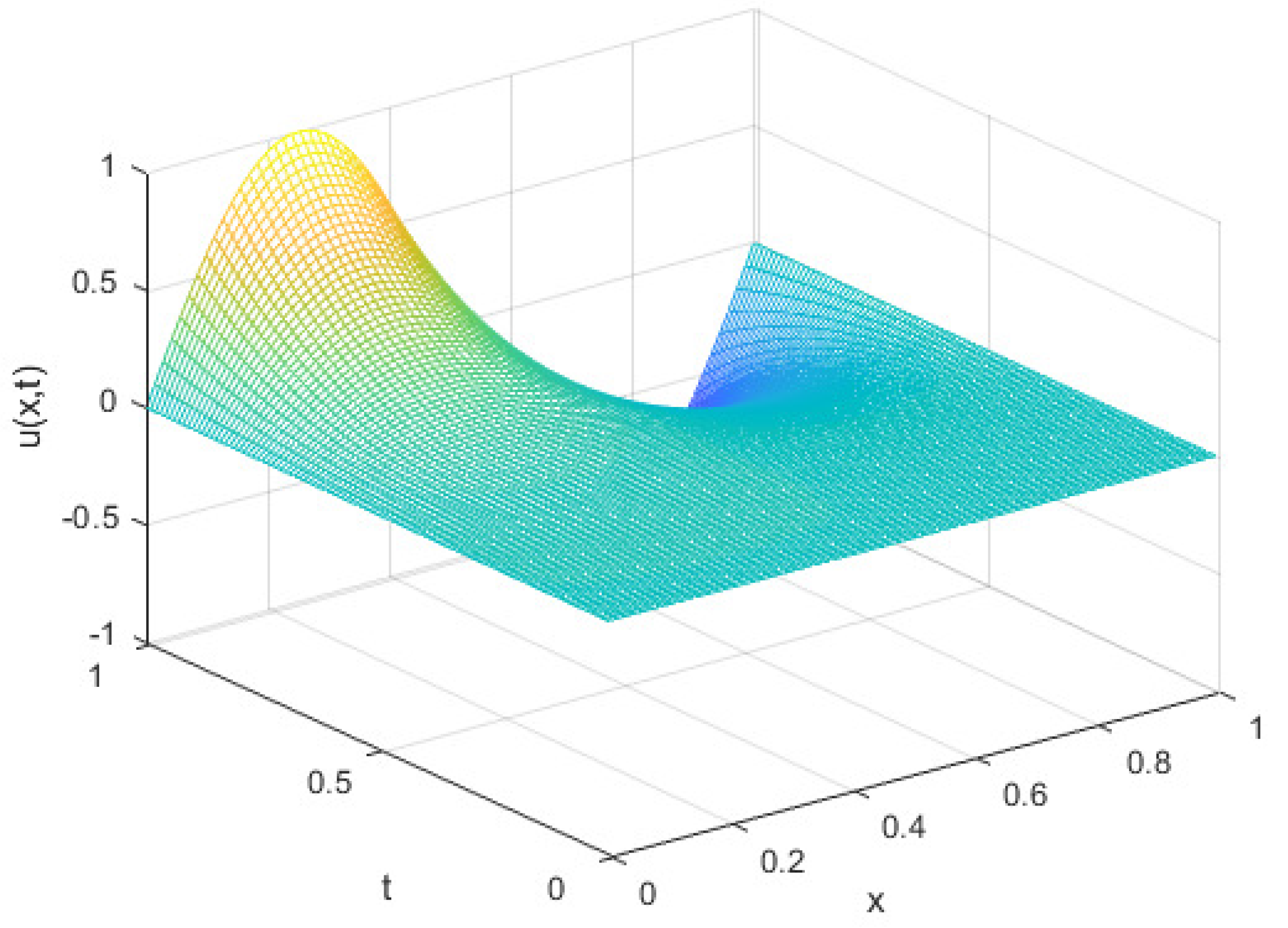
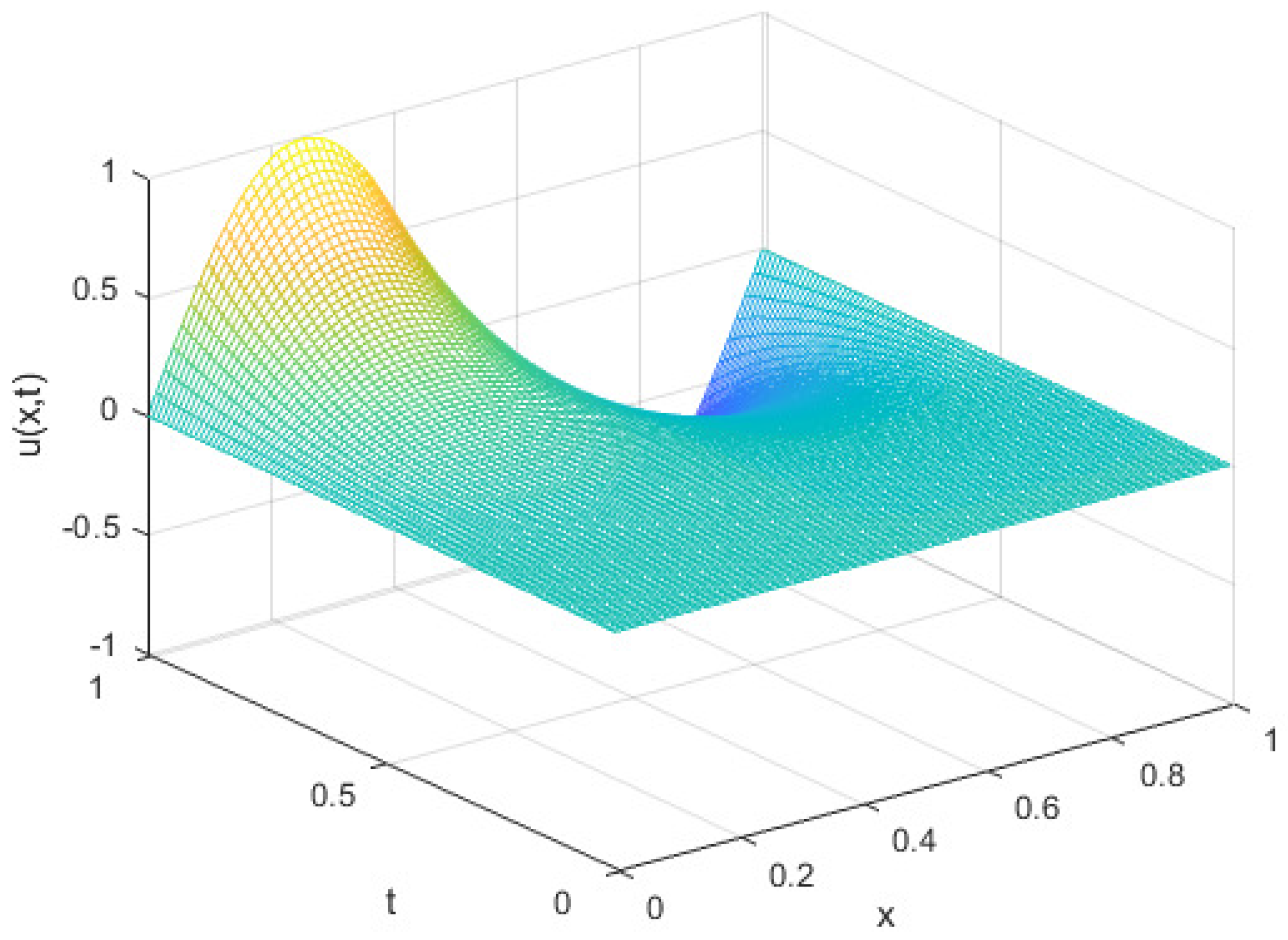
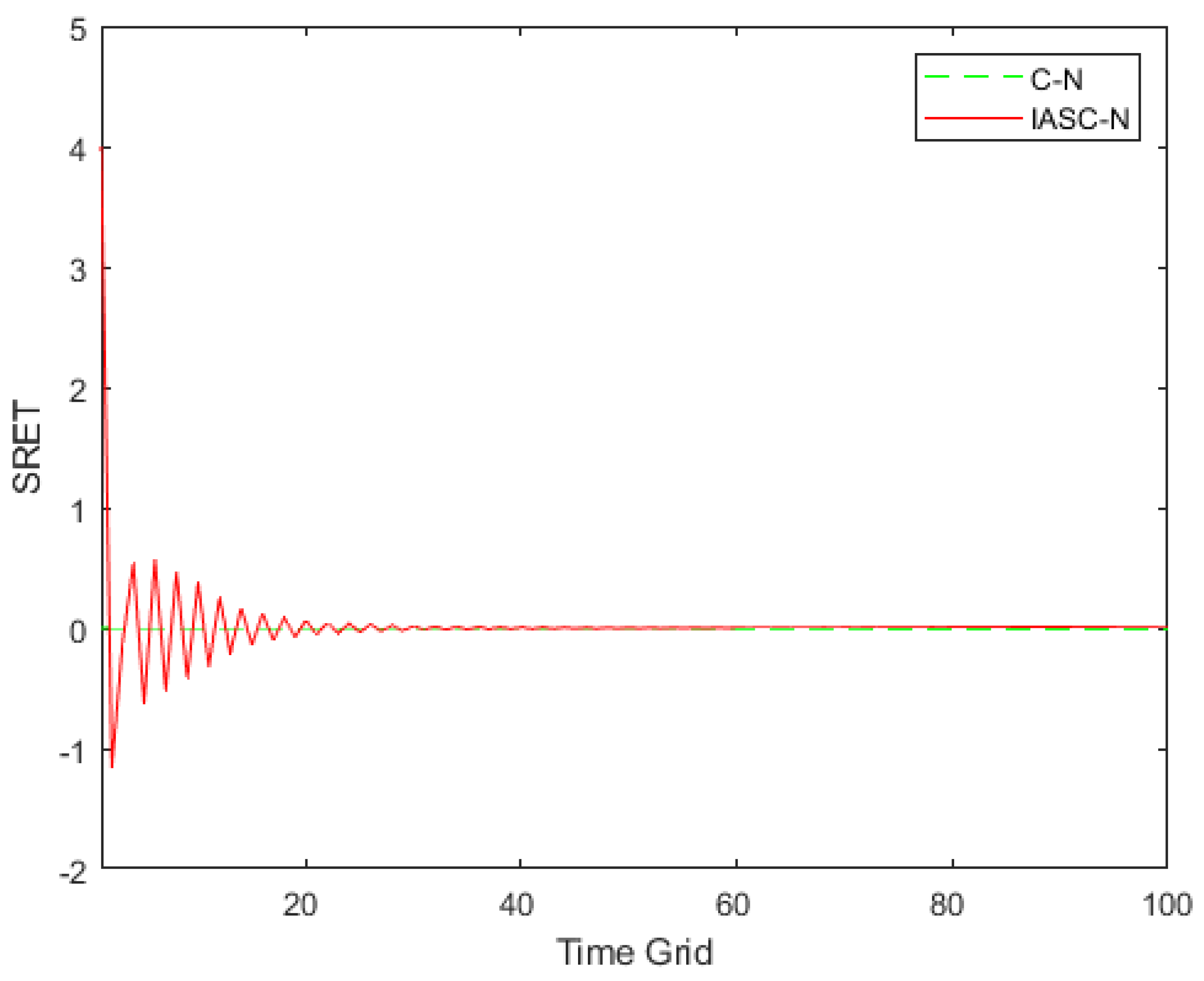
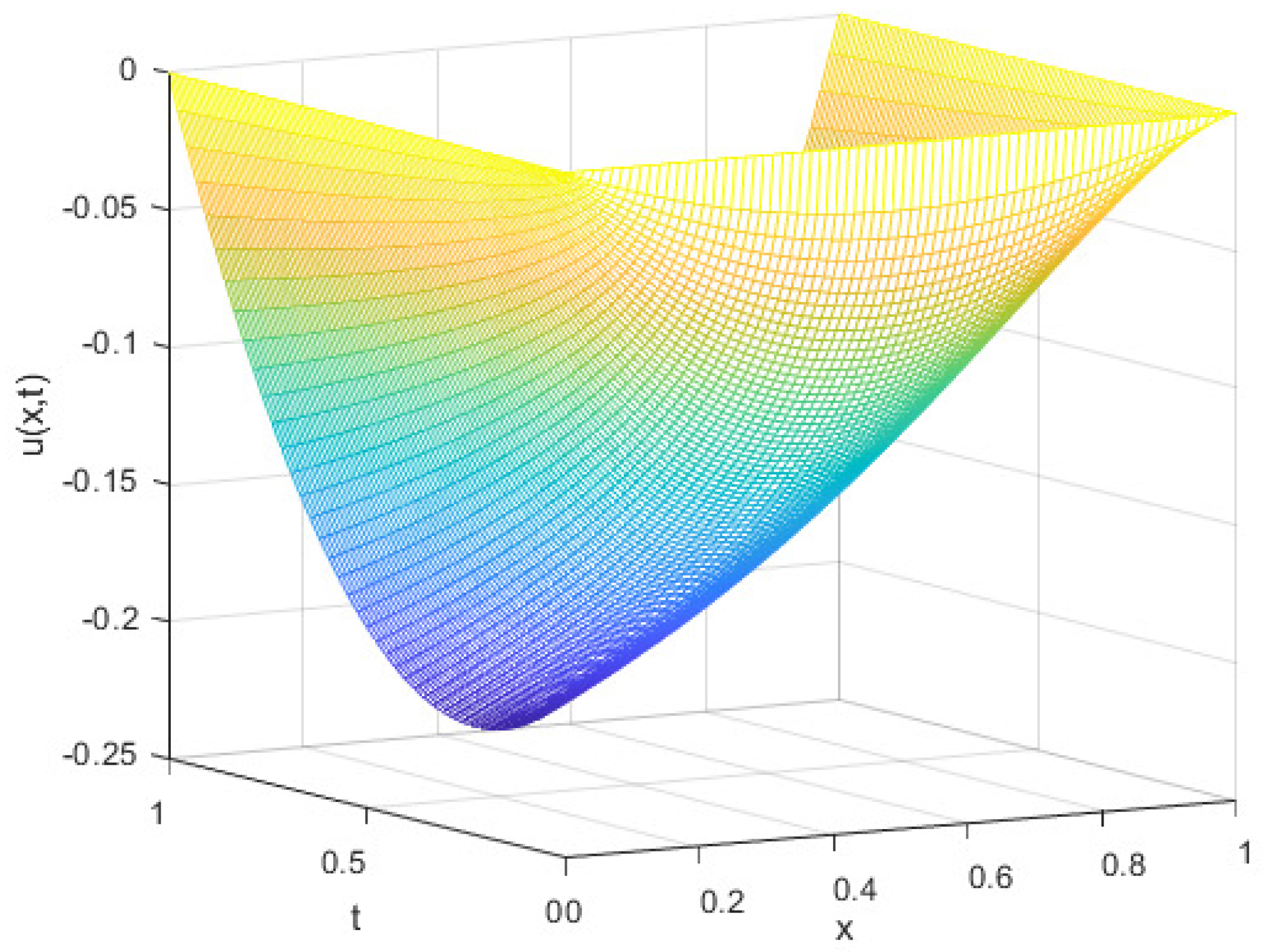

| x | ||||
|---|---|---|---|---|
| 0.25 | 0.5 | 0.75 | ||
| 0.3 | Exact solution | 5.752108 × 10 | 2.549964 × 10 | −5.763390 × 10 |
| HASC-N scheme solution | 5.517192 × 10 | 2.529212 × 10 | −5.600727 × 10 | |
| 0.5 | Exact solution | 5.752108 × 10 | 2.549964 × 10 | −5.763390 × 10 |
| HASC-N scheme solution | 5.565180 × 10 | 2.490347 × 10 | −5.608690 × 10 | |
| 0.7 | Exact solution | 5.752108 × 10 | 2.549964 × 10 | −5.763390 × 10 |
| HASC-N scheme solution | 5.605673 × 10 | 2.486836 × 10 | −5.629021 × 10 | |
| M | N | |||
|---|---|---|---|---|
| 0.5 | 21 | 100 | 5.805049 × 10 | |
| 41 | 400 | 1.535960 × 10 | 1.987252 | |
| 81 | 1600 | 3.930984 × 10 | 2.001614 | |
| 161 | 6400 | 9.953251 × 10 | 1.999513 | |
| 0.7 | 21 | 100 | 5.272847 × 10 | |
| 41 | 400 | 1.326208 × 10 | 2.062997 | |
| 81 | 1600 | 3.261035 × 10 | 2.060378 | |
| 161 | 6400 | 7.997470 × 10 | 2.045991 | |
| 0.9 | 21 | 100 | 4.857505 × 10 | |
| 41 | 400 | 1.220010 × 10 | 2.065118 | |
| 81 | 1600 | 3.029576 × 10 | 2.045922 | |
| 161 | 6400 | 7.518864 × 10 | 2.028652 |
| M | N | |||
|---|---|---|---|---|
| 0.5 | 101 | 16 | 1.035923 × 10 | |
| 32 | 3.687553 × 10 | 1.490181 | ||
| 64 | 1.303842 × 10 | 1.499895 | ||
| 128 | 4.594546 × 10 | 1.504774 | ||
| 0.7 | 101 | 16 | 9.512878 × 10 | |
| 32 | 3.879871 × 10 | 1.293873 | ||
| 64 | 1.578013 × 10 | 1.297899 | ||
| 128 | 6.392140 × 10 | 1.303738 | ||
| 0.9 | 101 | 16 | 8.555828 × 10 | |
| 32 | 3.996333 × 10 | 1.098231 | ||
| 64 | 1.865814 × 10 | 1.098872 | ||
| 128 | 8.681042 × 10 | 1.103865 |
| M | 201 | 401 | 601 | 801 | 1001 | 1201 |
|---|---|---|---|---|---|---|
| 0.123251 | 0.325116 | 0.466755 | 0.879479 | 1.357376 | 1.891728 | |
| 0.041364 | 0.106737 | 0.151507 | 0.282110 | 0.421785 | 0.582479 | |
| 2.979668 | 3.045954 | 3.080749 | 3.117504 | 3.218170 | 3.247719 | |
| 1.489834 | 1.522977 | 1.540374 | 1.558752 | 1.609085 | 1.623860 |
| M | N | |||
|---|---|---|---|---|
| 0.5 | 21 | 100 | 1.820529 × 10 | |
| 41 | 400 | 4.481606 × 10 | 2.095107 | |
| 81 | 1600 | 1.114969 × 10 | 2.043181 | |
| 161 | 6400 | 2.783025 × 10 | 2.020325 | |
| 0.7 | 21 | 100 | 2.197871 × 10 | |
| 41 | 400 | 5.454330 × 10 | 2.083051 | |
| 81 | 1600 | 1.359905 × 10 | 2.040008 | |
| 161 | 6400 | 3.395738 × 10 | 2.019752 | |
| 0.9 | 21 | 100 | 2.440139 × 10 | |
| 41 | 400 | 6.093245 × 10 | 2.073776 | |
| 81 | 1600 | 1.522336 × 10 | 2.036982 | |
| 161 | 6400 | 3.804131 × 10 | 2.018681 |
| M | N | |||
|---|---|---|---|---|
| 0.5 | 101 | 16 | 1.939613 × 10 | |
| 32 | 1.355892 × 10 | 0.516527 | ||
| 64 | 9.510714 × 10 | 0.511617 | ||
| 128 | 6.674831 × 10 | 0.510822 | ||
| 0.7 | 101 | 16 | 1.137173 × 10 | |
| 32 | 6.929028 × 10 | 0.714727 | ||
| 64 | 4.230193 × 10 | 0.711930 | ||
| 128 | 2.590579 × 10 | 0.707449 | ||
| 0.9 | 101 | 16 | 1.424087 × 10 | |
| 32 | 7.566100 × 10 | 0.912416 | ||
| 64 | 4.024197 × 10 | 0.910849 | ||
| 128 | 2.154974 × 10 | 0.901031 |
| x | ||||
|---|---|---|---|---|
| 0.25 | 0.5 | 0.75 | ||
| 0.3 | Exact solution | 6.540829 × 10 | 9.271849 × 10 | 6.816085 × 10 |
| HASC-N scheme solution | 6.538316 × 10 | 9.323716 × 10 | 6.823412 × 10 | |
| 0.5 | Exact solution | 5.807393 × 10 | 8.198668 × 10 | 6.048696 × 10 |
| HASC-N scheme solution | 5.844902 × 10 | 8.303472 × 10 | 6.094448 × 10 | |
| 0.7 | Exact solution | 5.171474 × 10 | 7.268177 × 10 | 5.383339 × 10 |
| HASC-N scheme solution | 5.199174 × 10 | 7.356311 × 10 | 5.417396 × 10 | |
| M | N | |||
|---|---|---|---|---|
| 0.1 | 21 | 100 | 4.456840 × 10 | |
| 41 | 400 | 3.011746 × 10 | 0.565421 | |
| 81 | 1600 | 2.088088 × 10 | 0.528418 | |
| 161 | 6400 | 1.448888 × 10 | 0.527236 | |
| 0.2 | 21 | 100 | 2.061921 × 10 | |
| 41 | 400 | 8.043848 × 10 | 1.358031 | |
| 81 | 1600 | 3.662202 × 10 | 1.135174 | |
| 161 | 6400 | 1.709010 × 10 | 1.099551 | |
| 0.3 | 21 | 100 | 1.064295 × 10 | |
| 41 | 400 | 5.183752 × 10 | 1.037830 | |
| 81 | 1600 | 2.538664 × 10 | 1.029927 | |
| 161 | 6400 | 1.330512 × 10 | 0.932088 | |
| 0.4 | 21 | 100 | 1.206877 × 10 | |
| 41 | 400 | 5.867005 × 10 | 1.040582 | |
| 81 | 1600 | 2.594804 × 10 | 1.176999 | |
| 161 | 6400 | 1.241889 × 10 | 1.063090 | |
| 0.5 | 21 | 100 | 1.505094 × 10 | |
| 41 | 400 | 6.260401 × 10 | 1.265527 | |
| 81 | 1600 | 2.542224 × 10 | 1.300164 | |
| 161 | 6400 | 1.017199 × 10 | 1.321489 | |
| 0.6 | 21 | 100 | 1.108872 × 10 | |
| 41 | 400 | 6.254087 × 10 | 0.826221 | |
| 81 | 1600 | 3.460837 × 10 | 0.853678 | |
| 161 | 6400 | 2.050544 × 10 | 0.755114 | |
| 0.7 | 21 | 100 | 1.210763 × 10 | |
| 41 | 400 | 5.822212 × 10 | 1.056277 | |
| 81 | 1600 | 2.310618 × 10 | 1.333288 | |
| 161 | 6400 | 1.009494 × 10 | 1.194646 | |
| 0.8 | 21 | 100 | 1.428816 × 10 | |
| 41 | 400 | 5.795162 × 10 | 1.301900 | |
| 81 | 1600 | 2.306303 × 10 | 1.329267 | |
| 161 | 6400 | 1.063531 × 10 | 1.116719 | |
| 0.9 | 21 | 100 | 1.789562 × 10 | |
| 41 | 400 | 7.830313 × 10 | 1.192465 | |
| 81 | 1600 | 2.261498 × 10 | 1.791791 | |
| 161 | 6400 | 9.787323 × 10 | 1.208293 |
| M | N | |||
|---|---|---|---|---|
| 0.1 | 101 | 16 | 3.235754 × 10 | |
| 32 | 1.322441 × 10 | 1.290898 | ||
| 64 | 3.805932 × 10 | 1.796882 | ||
| 128 | 1.137961 × 10 | 1.741799 | ||
| 0.2 | 101 | 16 | 3.400465 × 10 | |
| 32 | 1.126743 × 10 | 1.593573 | ||
| 64 | 3.902410 × 10 | 1.529722 | ||
| 128 | 1.266599 × 10 | 1.623405 | ||
| 0.3 | 101 | 16 | 1.441621 × 10 | |
| 32 | 4.722499 × 10 | 1.610070 | ||
| 64 | 1.306512 × 10 | 1.853830 | ||
| 128 | 4.114175 × 10 | 1.667045 | ||
| 0.4 | 101 | 16 | 4.485998 × 10 | |
| 32 | 2.509118 × 10 | 0.838249 | ||
| 64 | 1.128387 × 10 | 1.152918 | ||
| 128 | 3.700395 × 10 | 1.608511 | ||
| 0.5 | 101 | 16 | 8.566342 × 10 | |
| 32 | 4.305125 × 10 | 0.992624 | ||
| 64 | 1.101626 × 10 | 1.966421 | ||
| 128 | 3.663051 × 10 | 1.588516 | ||
| 0.6 | 101 | 16 | 1.175347 × 10 | |
| 32 | 4.492863 × 10 | 1.387380 | ||
| 64 | 1.211080 × 10 | 1.891341 | ||
| 128 | 3.668064 × 10 | 1.723204 | ||
| 0.7 | 101 | 16 | 1.384476 × 10 | |
| 32 | 4.957889 × 10 | 1.481543 | ||
| 64 | 1.458671 × 10 | 1.765071 | ||
| 128 | 4.035364 × 10 | 1.853884 | ||
| 0.8 | 101 | 16 | 1.572810 × 10 | |
| 32 | 5.660295 × 10 | 1.474396 | ||
| 64 | 1.851979 × 10 | 1.611810 | ||
| 128 | 5.576710 × 10 | 1.731581 | ||
| 0.9 | 101 | 16 | 1.769765 × 10 | |
| 32 | 6.605010 × 10 | 1.421925 | ||
| 64 | 2.405686 × 10 | 1.457112 | ||
| 128 | 8.758845 × 10 | 1.457636 |
Publisher’s Note: MDPI stays neutral with regard to jurisdictional claims in published maps and institutional affiliations. |
© 2022 by the authors. Licensee MDPI, Basel, Switzerland. This article is an open access article distributed under the terms and conditions of the Creative Commons Attribution (CC BY) license (https://creativecommons.org/licenses/by/4.0/).
Share and Cite
Liu, R.; Yang, X.; Lyu, P. A New Parallelized Computation Method of HASC-N Difference Scheme for Inhomogeneous Time Fractional Fisher Equation. Fractal Fract. 2022, 6, 259. https://doi.org/10.3390/fractalfract6050259
Liu R, Yang X, Lyu P. A New Parallelized Computation Method of HASC-N Difference Scheme for Inhomogeneous Time Fractional Fisher Equation. Fractal and Fractional. 2022; 6(5):259. https://doi.org/10.3390/fractalfract6050259
Chicago/Turabian StyleLiu, Ren, Xiaozhong Yang, and Peng Lyu. 2022. "A New Parallelized Computation Method of HASC-N Difference Scheme for Inhomogeneous Time Fractional Fisher Equation" Fractal and Fractional 6, no. 5: 259. https://doi.org/10.3390/fractalfract6050259
APA StyleLiu, R., Yang, X., & Lyu, P. (2022). A New Parallelized Computation Method of HASC-N Difference Scheme for Inhomogeneous Time Fractional Fisher Equation. Fractal and Fractional, 6(5), 259. https://doi.org/10.3390/fractalfract6050259






